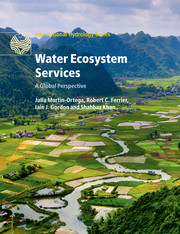Book contents
- Frontmatter
- Contents
- List of contributors
- Preface
- 1 Introduction
- 2 What defines ecosystem services-based approaches?
- Part I Addressing global challenges
- Part II Applying frameworks for water management and biodiversity conservation under an ecosystem services-based approach
- Part III Assessing water ecosystem services
- Part IV Broadening the perspective
- 15 Ecosystem services-based approaches to water management: what opportunities and challenges for business?
- 16 Key factors for successful application of ecosystem services-based approaches to water resources management: the role of stakeholder participation
- 17 Cultural ecosystem services, water, and aquatic environments
- 18 The psychological dimension of water ecosystem services
- 19 The interface between human rights and ecosystem services
- 20 Water ecosystem services: moving forward
- Index
- Plate Section
- References
17 - Cultural ecosystem services, water, and aquatic environments
from Part IV - Broadening the perspective
Published online by Cambridge University Press: 05 May 2015
- Frontmatter
- Contents
- List of contributors
- Preface
- 1 Introduction
- 2 What defines ecosystem services-based approaches?
- Part I Addressing global challenges
- Part II Applying frameworks for water management and biodiversity conservation under an ecosystem services-based approach
- Part III Assessing water ecosystem services
- Part IV Broadening the perspective
- 15 Ecosystem services-based approaches to water management: what opportunities and challenges for business?
- 16 Key factors for successful application of ecosystem services-based approaches to water resources management: the role of stakeholder participation
- 17 Cultural ecosystem services, water, and aquatic environments
- 18 The psychological dimension of water ecosystem services
- 19 The interface between human rights and ecosystem services
- 20 Water ecosystem services: moving forward
- Index
- Plate Section
- References
Summary
17.1 INTRODUCTION
Cultural ecosystem services have proved a highly challenging area for undertaking ecosystem assessments and developing ecosystem services-based approaches that can be incorporated within decision-making. Cultural ecosystem services are clearly core to understanding how ecosystems relate to human well-being since they focus on the cultural and social processes by which humans and the non-human interact. This involves activities, such as recreation, and spaces, such as parks and gardens, that are at the centre of everyday life. The problematic dimension of cultural ecosystem services is that it brings the longstanding philosophical and social theory debates over the meaning of culture into an approach to understanding the natural environment that has largely emerged out of natural science and economics. Ecosystem services-based approaches encourage classification and measurement which is often highly problematic when considering cultural entities and practices that resist simple definitions. Furthermore, the cultural aspects of ecosystems are not just confined to cultural ecosystem services. For example, Holmlund and Hammer (1999) discuss food production as a cultural service, whereas the Millennium Ecosystem Assessment (2005) would define food as a provisioning service. As Fish (2011, pp.674–675) notes, it ‘is probably more accurate to think of “culture” less as a separate “box” within the services typology […]. In what sense, for instance, is the provision of “food” not also a cultural ecosystem service?’
The same arguments can be applied to water in that how water is treated and ‘mis-treated’ in any society will to a significant degree be influenced by cultural attitudes. There is a large literature on the cultural significance of water which highlights how different societies currently and historically have understood the significance of water and attached distinct political, cultural, and social meanings to water (Toussaint 2006). Strang (2006) argues that it is also important to recognise the crosscultural ‘flows’ relating to water and points out that in Western society and for some Australian Aboriginal peoples immersion in water can be a highly significant spiritual act.
- Type
- Chapter
- Information
- Water Ecosystem ServicesA Global Perspective, pp. 148 - 155Publisher: Cambridge University PressPrint publication year: 2015

